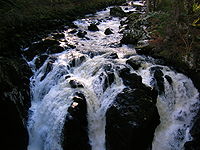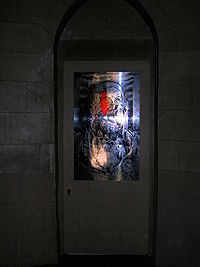
Ossian's Hall of Mirrors
Encyclopedia
Ossian's Hall of Mirrors is a Georgian
structure located at The Hermitage
in Dunkeld
, Scotland
.


 The Hermitage and Ossian's Hall of Mirrors was originally an unremarkable view-house in a position overlooking the Black Linn falls of the Braan, a tributary of the River Tay
The Hermitage and Ossian's Hall of Mirrors was originally an unremarkable view-house in a position overlooking the Black Linn falls of the Braan, a tributary of the River Tay
. This folly was built on a rocky outcrop for the 2nd Duke of Atholl
in 1757.
 The Hermitage was redecorated in 1783 as a shrine to the blind bard, Ossian
The Hermitage was redecorated in 1783 as a shrine to the blind bard, Ossian
. Ossian is supposed to have lived and written his heroic verse around the 3rd century.
The redecorated hall was intended to evoke features of 'shock' and 'amazement' in the viewers' minds; the room from where views of the waterfall were taken was lined with mirrors which made the spectator imagine that the water was appearing from all angles. William Wordsworth composed a poem which described the 'World of Wonder' in this room. Another description states that in the 1780s, visitors entering were met by a painting of Ossian
serenading a group of maidens. The guide operated a device that withdrew the painting into the wall, providing access to another room - a hall of mirrors - giving the illusion of water pouring all around reflecting the river cascading outside. In 1803 the hall had walks that were intersected, here and there, by a small garden of fine flowers among rocks and stones'. These small-scale gardens have since gone.
In 1803 Dorothy Wordsworth wrote Our guide opened a door, and we entered a dungeon-like passage, and, after walking some yards in total darkness, found ourselves in a quaint apartment stuck over with moss, hung about with stuffed foxes and other wild animals, and ornamented with a library of wooden books covered with old leather backs, and mock furniture of a hermit's cell. At the end of the room, through a large bow window, we saw the waterfall ... a very beautiful prospect.

to the National Trust for Scotland
in accordance with the wishes of the late Duke. The National Trust for Scotland has restored the building for the use and enjoyment of the public, however the mirrors do not operate to give the optical illusions that they did originally.
Georgian era
The Georgian era is a period of British history which takes its name from, and is normally defined as spanning the reigns of, the first four Hanoverian kings of Great Britain : George I, George II, George III and George IV...
structure located at The Hermitage
The Hermitage (Scotland)
The Hermitage is a National Trust for Scotland-protected site in Dunkeld, Perth and Kinross. Located just to the west of the A9, it sits on the banks of the River Braan in Craigvinean Forest...
in Dunkeld
Dunkeld
Dunkeld is a small town in Strathtay, Perth and Kinross, Scotland. It is about 15 miles north of Perth on the eastern side of the A9 road into the Scottish Highlands and on the opposite side of the Tay from the Victorian village of Birnam. Dunkeld and Birnam share a railway station, on the...
, Scotland
Scotland
Scotland is a country that is part of the United Kingdom. Occupying the northern third of the island of Great Britain, it shares a border with England to the south and is bounded by the North Sea to the east, the Atlantic Ocean to the north and west, and the North Channel and Irish Sea to the...
.

The original view-house


River Tay
The River Tay is the longest river in Scotland and the seventh-longest in the United Kingdom. The Tay originates in western Scotland on the slopes of Ben Lui , then flows easterly across the Highlands, through Loch Dochhart, Loch Lubhair and Loch Tay, then continues east through Strathtay , in...
. This folly was built on a rocky outcrop for the 2nd Duke of Atholl
Duke of Atholl
Duke of Atholl, alternatively Duke of Athole, named after Atholl in Scotland, is a title in the Peerage of Scotland held by the head of Clan Murray...
in 1757.
Ossian's shrine

Ossian
Ossian is the narrator and supposed author of a cycle of poems which the Scottish poet James Macpherson claimed to have translated from ancient sources in the Scots Gaelic. He is based on Oisín, son of Finn or Fionn mac Cumhaill, anglicised to Finn McCool, a character from Irish mythology...
. Ossian is supposed to have lived and written his heroic verse around the 3rd century.
The redecorated hall was intended to evoke features of 'shock' and 'amazement' in the viewers' minds; the room from where views of the waterfall were taken was lined with mirrors which made the spectator imagine that the water was appearing from all angles. William Wordsworth composed a poem which described the 'World of Wonder' in this room. Another description states that in the 1780s, visitors entering were met by a painting of Ossian
Ossian
Ossian is the narrator and supposed author of a cycle of poems which the Scottish poet James Macpherson claimed to have translated from ancient sources in the Scots Gaelic. He is based on Oisín, son of Finn or Fionn mac Cumhaill, anglicised to Finn McCool, a character from Irish mythology...
serenading a group of maidens. The guide operated a device that withdrew the painting into the wall, providing access to another room - a hall of mirrors - giving the illusion of water pouring all around reflecting the river cascading outside. In 1803 the hall had walks that were intersected, here and there, by a small garden of fine flowers among rocks and stones'. These small-scale gardens have since gone.
In 1803 Dorothy Wordsworth wrote Our guide opened a door, and we entered a dungeon-like passage, and, after walking some yards in total darkness, found ourselves in a quaint apartment stuck over with moss, hung about with stuffed foxes and other wild animals, and ornamented with a library of wooden books covered with old leather backs, and mock furniture of a hermit's cell. At the end of the room, through a large bow window, we saw the waterfall ... a very beautiful prospect.

Early literary accounts of the Hall of Mirrors
Garnett in 1800 visited the site. He describes the 'Hall of Mirrors' as having its sides and ceiling covered with mirrors, in which the cascade is feen by reflexion, sometimes running upwards, contrary to the direction of gravity, and sometimes in a horizontal stream over the head.The decline and restoration of the site
In 1869 vandals blew up part of Ossian's Hall and the area was left to decay. In 1943 the 8th Duchess of Atholl donated it and 33 acres (13.3ha) of, by then, coniferous woodland along the banks of the River BraanRiver Braan
The River Braan is a tributary of the River Tay in Scotland.Within the county of Perth and Kinross, it flows 11 miles eastwards from Loch Freuchie, near Amulree, and joins the River Tay near Dunkeld.-References:* - Geo.ed.ac.uk-External links:...
to the National Trust for Scotland
National Trust for Scotland
The National Trust for Scotland for Places of Historic Interest or Natural Beauty, commonly known as the National Trust for Scotland describes itself as the conservation charity that protects and promotes Scotland's natural and cultural heritage for present and future generations to...
in accordance with the wishes of the late Duke. The National Trust for Scotland has restored the building for the use and enjoyment of the public, however the mirrors do not operate to give the optical illusions that they did originally.

